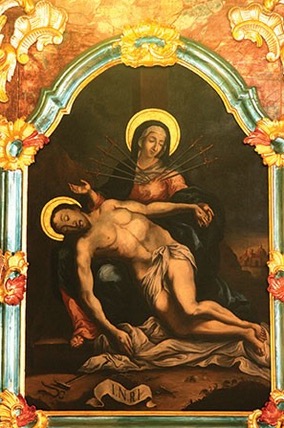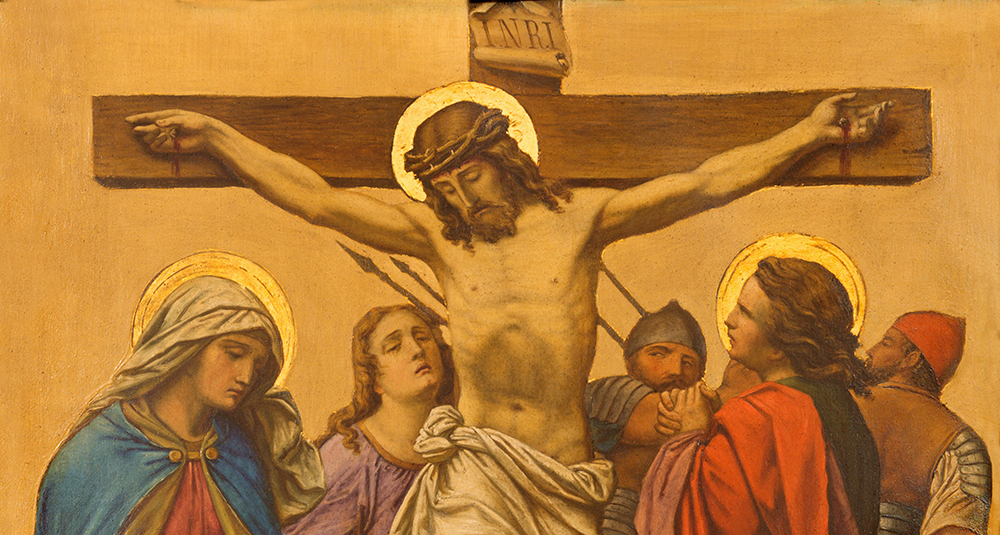Each September the Church celebrates the feast of the Exaltation of the Holy Cross on Sept. 14, and the memorial of Our Lady of Sorrows follows on Sept. 15.
The pairing of these celebrations, even in their different levels on the liturgical and sanctoral calendars, properly guides us in our levels of devotion and love of our Savior and Our Lady. He is our Divine Redeemer, to be worshiped and adored; she is His first disciple and our example. Both of these celebrations have a long history and are worthy of meditation.
Recovery of the Holy Cross
The feast of the Triumph of the Cross was observed in Rome in the late seventh century to commemorate the recovery of the Holy Cross by Byzantine Emperor Heraclius in 629. St. Helena, Emperor Constantine’s mother, had found the True Cross in Jerusalem in the fourth century, but the Persians had captured it and only returned it after Heraclius defeated the Persian king Khosrau II. The emperor returned it to Jerusalem, and this feast recalls that event. As he approached the holy city, dressed in fine robes and festooned with jewels, the emperor found himself unable to process further until Zacharias, Patriarch of Jerusalem, told Heraclius to humble himself by removing his imperial regalia and proceeding as a barefoot pilgrim.
But on a deeper level, of course, the feast recalls Jesus’ triumph over death and the fulfillment of His great statement, “When I am lifted up from the earth, I will draw everyone to myself” (Jn 12:32, which serves as the Communion Antiphon on this feast). The liturgy of the Mass for this feast includes both triumph and sorrow in the readings and prayers, since Jesus both suffers His passion and defeats sin and death. From the Book of Numbers (21:4b-9), the first reading recalls the story of Moses and the bronze Seraph, raised on a pole — when the people of Israel, who had been grumbling against God for their sufferings, looked up to the serpent, they were healed of the serpent bites God had sent to afflict them.
The responsorial psalm is a poetic reminder of how God has forgiven His people for their betrayal:
“But they flattered him with their mouths / and lied to him with their tongues . . .
“Yet he, being merciful, forgave their sin / and destroyed them not . . . “
The second reading is the great hymn of Jesus’ humility and exaltation from St. Paul’s Letter to Philippians (2:6-11): “Though he was in the form of God . . . he emptied himself . . . he humbled himself . . . becoming obedient to death, even death on a cross.” After this falling movement in the reading, Jesus rises:
“Because of this, God greatly exalted him / And bestowed on him the name / That is above every name, / That at the name of Jesus / Every knee should bend, / Those in heaven and on earth and under the earth, / And every tongue confess that / Jesus Christ is Lord, / To the glory of God the Father.” (In the Extraordinary Form of the Latin Rite, also known as the Tridentine Rite, the congregation genuflects at the words “Every knee should bend” when this reading occurs.)
And, finally, in the Gospel from St. John (3:13-17), Jesus makes the connection between Moses and the Seraph and himself, as He tells Nicodemus that He must be lifted up so that those who believe in Him will have eternal life. From that passage comes the great John 3:16: “For God so loved the world that he gave his only Son, so that everyone who believes in him might not perish but might have eternal life.”
Like the commemoration of Good Friday during Holy Week, the feast of the Exaltation of the Holy Cross reminds us of the wondrous contradiction at the heart of our faith: that we are redeemed by the suffering and the sacrifice of Jesus Christ, offered to God the Father.
As Pope Benedict XVI remarked during his general audience on Oct. 29, 2008:
“The Cross, for all it represents, hence also for the theological message it contains, is scandal and folly. The apostle says so with an impressive force that it is good to hear directly from his words: ‘for the word of the Cross is folly to those who are perishing, but to us who are being saved it is the power of God … it pleased God through the folly of what we preach to save those who believe. For Jews demand signs and Greeks seek wisdom, but we preach Christ crucified, a stumbling block to Jews and folly to Gentiles’ (1 Cor 1:18-23).”
His Sorrowful Mother

Shutterstock
Sept. 15 then recalls the sorrow of Our Lady at the foot of the Cross as the fulfillment of Simeon’s prophecy at the Presentation of Jesus in the Temple: “(and you yourself a sword shall pierce) so that the thoughts of many hearts may be revealed” (Lk 2:35). The Gospel for Mass that day may be either the description of “his mother and the disciple . . . whom he loved” standing by the cross of Jesus (Jn 19:25-27) or the Presentation in the Temple (Lk 2:33-35).
The sequence Stabat Mater — often sung while praying the Stations of the Cross — may be chanted after the Psalm. According to Lumen Gentium (the Second Vatican Council’s Dogmatic Constitution on the Church), “the Blessed Virgin advanced in her pilgrimage of faith, and faithfully persevered in her union with her Son unto the cross, where she stood, in keeping with the divine plan, grieving exceedingly with her only begotten Son, uniting herself with a maternal heart with His sacrifice, and lovingly consenting to the immolation of this Victim which she herself had brought forth” (No. 58).
The readings and prayers of the Mass focus on Mary’s special sorrows, but also on her glory, as the Alleluia verse proclaims, “Blessed are you, O Blessed Virgin Mary; without dying you won the martyr’s crown beside the cross of the Lord.”
Devotion to Our Lady of Sorrows became very popular in the monastic Cistercian and mendicant Servite orders in the 13th century. The memorial was first celebrated by the Servites; then Pope Pius VII added it to the Roman Calendar in 1814. Pope St. Pius X moved the memorial to Sept. 15 in 1913. The Servites gave us the Chaplet of Our Lady of Sorrows encouraging meditation on seven events in the life of Mary:
The Prophecy of Simeon (see Lk 2:34-35)
The Flight into Egypt (Mt 2:13-15)
The Loss of the Child Jesus in the Temple (Lk 2:43-45)
Mary Meets Jesus on the Way to Calvary (from the Stations of the Cross)
Jesus Dies on the Cross (Jn 19:25-30)
Mary Receives the Body of Jesus in Her Arms (Mt 27:57-59)
The Body of Jesus Is Placed in the Tomb (Jn 19:40-42)
In religious art, Our Lady of Sorrows is depicted in three ways: as the Stabat Mater, standing by the cross; in the Pietà as an object of pity (most famously in Michelangelo’s sculpture, but also very movingly in Mel Gibson’s movie “The Passion of the Christ”); and as the Mater Dolorosa, Mother of Sorrows, often with seven swords (the seven sorrows) piercing her Immaculate Heart. The Stabat Mater sequence has been set to music by composers from Antonin Dvorak to Domenico Scarlatti, from Joseph Haydn to Arvo Pärt, and others, in styles ranging from Renaissance polyphony to almost operatic oratorio.
As the entrance antiphon for the feast of the Exaltation of the Holy Cross proclaims, “We should glory in the Cross of our Lord Jesus Christ, in whom is our salvation, life and resurrection, through whom we are saved and delivered” (based on Galatians 6:14), even as we mourn with Our Lady: “At the Cross her station keeping / Stood the mournful Mother weeping / Close to Jesus to the last.”
Stephanie A. Mann writes from Kansas.
“What a Great Thing It is to Possess the Cross!”
“What a great thing it is to possess the Cross! He who possesses it possesses a treasure” (St. Andrew of Crete, Homily X on the Exaltation of the Cross, PG 97, 1020)…. The instrument of torture which, on Good Friday, manifested God’s judgment on the world, has become a source of life, pardon, mercy, a sign of reconciliation and peace. “In order to be healed from sin, gaze upon Christ crucified!” said St. Augustine (Treatise on St. John, XII, 11). By raising our eyes toward the Crucified One, we adore Him who came to take upon himself the sin of the world and to give us eternal life. And the Church invites us proudly to lift up this glorious Cross so that the world can see the full extent of the love of the Crucified One for mankind, for every man and woman. She invites us to give thanks to God because from a tree which brought death life has burst out anew. On this wood Jesus reveals to us His sovereign majesty, He reveals to us that He is exalted in glory. Yes, “Come, let us adore Him!” In our midst is He who loved us even to giving His life for us, He who invites every human being to draw near to Him with trust.
This is the great mystery that Mary also entrusts to us this morning, inviting us to turn toward her Son. In fact, it is significant that, during the first apparition to Bernadette, Mary begins the encounter with the Sign of the Cross. More than a simple sign, it is an initiation into the mysteries of the faith that Bernadette receives from Mary. The Sign of the Cross is a kind of synthesis of our faith, for it tells how much God loves us; it tells us that there is a love in this world that is stronger than death, stronger than our weaknesses and sins. The power of love is stronger than the evil which threatens us.
Pope Benedict XVI, Sept. 14, 2008, at Lourdes

